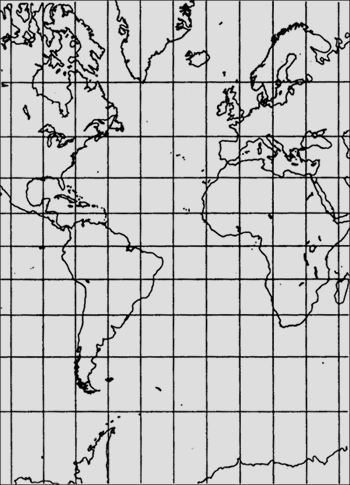 |


|
Lesson 3 Activity 1: On the Trail of Knowledge
Plot the earthquake epicenter data (see page 5), on the base map of the North Atlantic ocean floor. Use different symbols or colors to characterize different values.
Time
One 50-minute class period.
Materials for each pair of students
- Earthquake data (page 5)
- Base map (page 5)
- Colored pens or pencils
- Ruler
- Scrap paper
Procedures
- Study the data to learn what information you have and to determine the range of values. This may be easiest to do by reorganizing the data in a new list or table. What are the lowest and highest magnitude values? Considering that the Richter scale of earthquake magnitude includes values from 0 to about 9, are mid-Atlantic earthquakes weak, medium, or strong?
- Consider generalizing or grouping data to simplify the mapping. In other words, decide whether you need to map all points to see the pattern in the data. Decide on symbols to use in plotting the data. Consider making a sample plot of some data points to test symbol size, color, etc.
- Plot data points by latitude and longitude coordinates on the base map. Use a ruler as needed to help estimate locations between latitude and longitude lines. Choose a descriptive title, and make a scale and legend for the map.
- Discuss the pattern revealed from mapping the data. Discuss the fact that two tsunami warning centers monitor the Pacific Ocean, but none monitors the Atlantic. What does this imply about magnitudes of earthquakes in the Pacific Ocean? (Note that Magellan commented on the appropriateness of the name of the Pacific Ocean.)
Extensions
Referring to the 1957 map of the ocean floor, and the quotation from Tharp's book, discuss this example of the process of scientific discovery.

Latitude Longitude Magnitude
21.77S 13.13W 4.7
32.14 14.10 4.4
30.73 41.66 4.6
27.13 44.46 4.7
33.65 38.57 4.8
6.44 33.08 5.1
33.74 33.29 4.8
13.50 44.79 4.3
7.37 35.29 5.7
17.20 14.28 4.6
0.54 19.76 4.6
14.64 23.52 4.2
8.47 37.50 4.7
3.62 31.55 4.7
1.21 24.42 5.1
38.37 16.59 5.0
26.71 44.61 4.5
0.94 26.53 4.9
23.63 13.41 4.6
28.45 43.74 5.3
44.75 15.60 4.8
4.52 12.29 5.1
0.07 17.52 5.8
44.62 28.38 4.8
4.37 10.78 4.8
0.54 14.27 4.8
39.91 29.68 4.3
37.10 33.04 4.4
7.14 34.20 4.8
0.96 28.81 5.2
35.43 35.65 6.0
17.70 13.25 5.1
9.53 40.60 4.9
13.97 14.51 5.0
41.31 29.35 4.5
27.72 44.08 4.9
0.26 20.89 4.8
24.89 13.58 4.6
43.65 16.16 5.3
0.06 16.67 5.0
7.62 36.03 5.0
35.21 17.13 4.9
8.28 38.51 4.0
43.73 28.86 5.7
2.16 30.74 4.7
0.98 26.70 4.5
42.55 16.14 5.4
21.03 11.48 4.9
1.13 24.44 4.9
Glossary
| base map |
compilation |
context |
distortion |
| generalization |
groupings |
isoline |
map design |
| orientation |
qualitative |
quantitative |
scale |
| bar scale |
representative fraction scale |
verbal scale |
large scale |
| small scale |
spatial data |
thematic map |
|
|
Intro & Lessons |
Teacher's Guide |
Explorers
|
|
|
 |
|